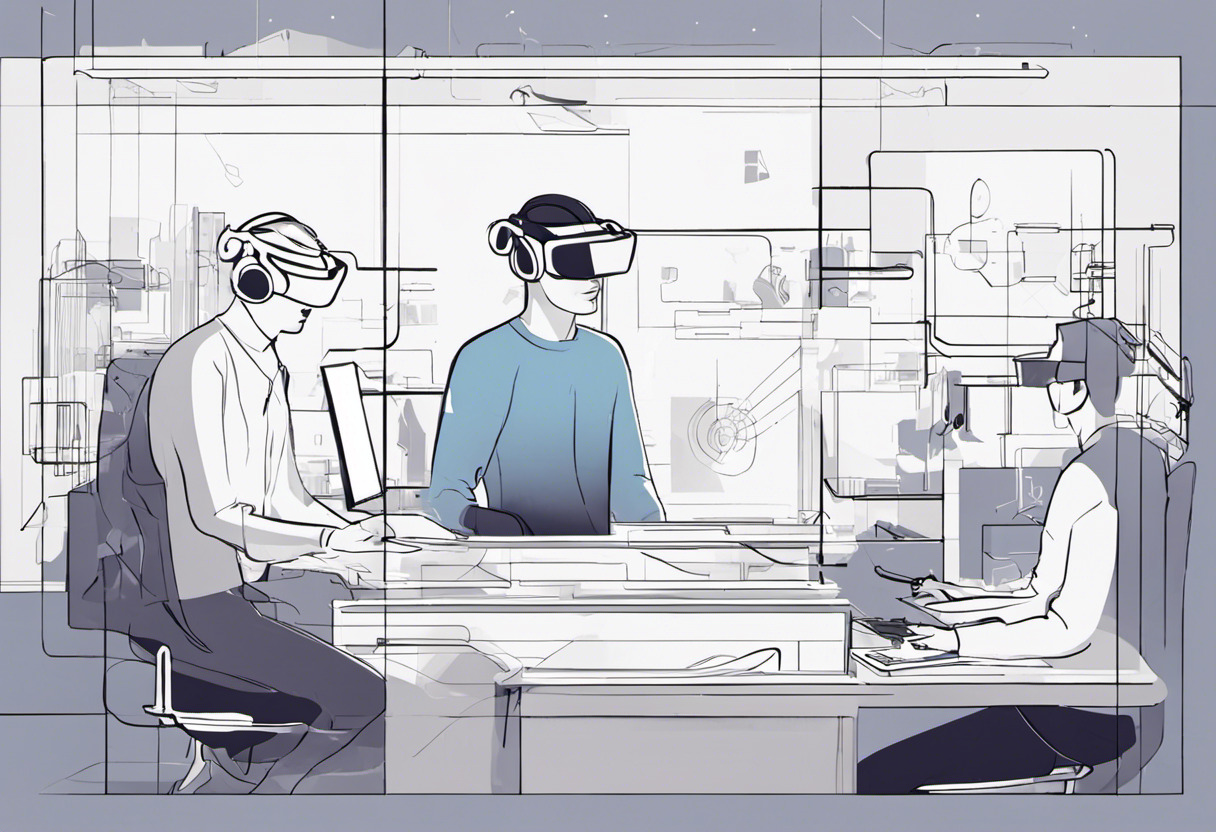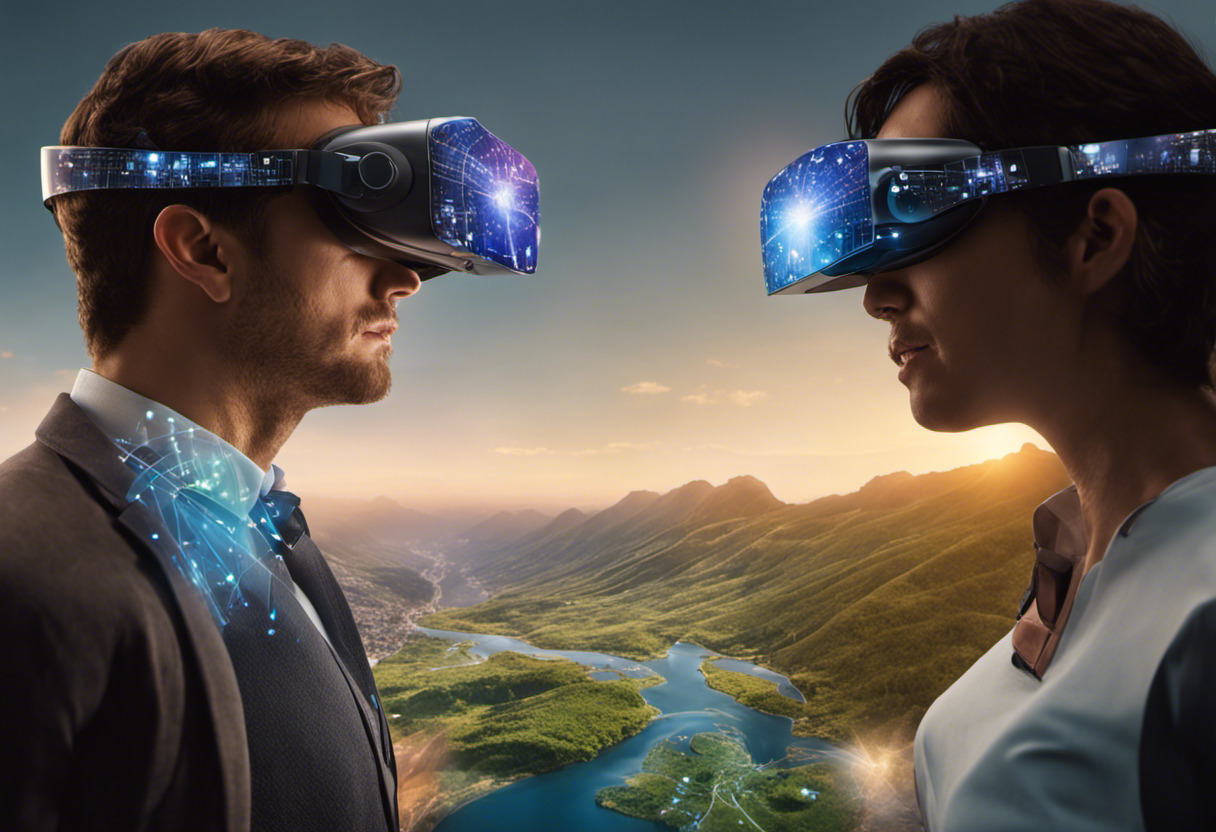Monetizing Web AR experiences can be achieved through strategic approaches like subscription models, pay-per-download, in-app purchases, and advertising, ensuring to retain high user experience. Emerging technologies like Web3 wallets integrated into WebAR platforms add potential for an immersive branded experience and new profitable pursuits.

Through this article, the reader will gain a comprehensive understanding of effective strategies for Web AR monetization and the pioneering developments reshaping its possibilities.
The Emergence of AR Advertising Revenue
In the past few years, the advertising landscape has witnessed a drastic shift, pivotally led by the rise of Augmented Reality (AR). With the advent of AR, digital advertising has transcended beyond the two-dimensional realm, stepping into an interactive and immersive world that captivates the audience like never before.
Two key players pioneering this transition are Snapchat and Meta, formerly known as Facebook. Their success in monetizing AR features provides invaluable insights into the potential of AR advertising.
Groundbreaking Success of Snapchat and Meta
Snapchat, through its Snap AR platform, has unleashed an assemblage of AR lenses and filters that have drawn a massive global audience. 
In response, advertisers have started to uncover the potential these AR features hold for promoting their products in more personal and interactive ways.
Similarly, Meta has also stepped into the AR advertising landscape through platforms like Instagram, integrating AR features into its advertising strategies. META’s AR ads often offer a ‘try before you buy’ aspect, sparking interest through interactivity.
The Surge in AR Advertising Revenue
- Highly Engaging Content: Thanks to the interactive nature of AR, users are more likely to interact with and share content that integrates AR features, ultimately driving up ad engagement rates.
- New Advertising Opportunities: AR opens new doors for advertisements, allowing marketers to deliver innovative campaigns that showcase their product in a whole new light.
- Improved Shopping Experience: With AR, customers can ‘try’ a product before purchasing, thus improving user experience and increasing the likelihood of a purchase.
Because of these advantages, it’s no surprise that advertisers are increasingly allocating budgets for AR campaigns. This shift is reflected in the predicted $2.86 billion in AR campaign spending for the current year, showcasing the substantial growth in AR advertising revenue.
What truly fuels this upward trajectory of AR advertising revenue? The answer lies in factors like higher user engagement, creative freedom and the unique interactive shopping experience offered by AR.
Drivers Behind the Growing AR Advertising Revenue
Instagram, under the METa umbrella, is a notable example of effectively leveraging AR features to boost advertising. The platform allows brands to create immersive AR filters associated with their products, which are then shared and used by Instagram’s global user base.
AR capabilities have also spread to search engines like Google, especially through software like Google Lens. This has allowed users to search for items simply by pointing their camera at them—an innovative feature that presents new advertising opportunities.
To comprehend the performance techniques behind the success of AR advertising, you can delve into this detailed resource on Web AR performance techniques. The guide can provide valuable insights into making AR advertising highly engaging and profitable.
Responding to the Demand
Interestingly, the rising demand for AR capabilities is not just from advertisers. Developers, marketers, tech enthusiasts, and businesses across industries are recognizing the potential and profitability of AR. This increase in AR/VR developers demand mirrors the growing trend of AR advertising, hinting at a future where AR becomes a fundamental part of our digital lives.

Considering the proven lucrative potential of AR advertising, the avenues to explore for online marketers, AR developers, and businesses in the AR/VR industry are vast. With AR, one can truly reimagine the landscape of online advertising.
Strategic Approaches in Monetizing VR/AR Products
In the evolving world of Virtual Reality (VR) and Augmented Reality (AR), numerous strategies have emerged to monetize products efficiently. Developers and businesses consider several factors, crucial among them being the product offering and target audience. We will scrutinize popular business models and additional revenue streams, emphasizing the impactful role of user experience throughout.

Understanding Different Business Models
The choice of a business model profoundly influences a product’s profitability and market appeal. Digital products, especially in the VR/AR domain, have seen a significant surge, served largely by three business models. This UI/UX principles guide provides detailed insights.
- Subscription Model: Here, users pay a regular fee to gain access to the product. This is prevalent in VR/AR experiences that offer continuous content updates. It ensures recurring revenue and maintains user engagement.
- Pay-per-download: In this model, users pay a one-time fee for downloading the application. This has been favoured by developers creating stand-alone VR/AR experiences with finite content.
- In-app Purchases: A free-to-download model where revenue is generated by users purchasing additional features or levels within the app. This model has seen great success in games and other interactive AR experiences.
Essentially, the selection of a business model needs to align well with the product and its perceived value by the target audience.
Capitalizing on Additional Revenue Streams
Besides the initial monetizing methods, VR/AR products can generate additional revenue from other creative avenues. However, these should not compromise the user experience, a key determinant of an application’s overall success. For an impactful engagement, learn about effective storytelling in this guide.
- Advertising: This involves showcasing paid ads within the application. However, ads should not be intrusive to the user experience. For instance, Instagram employs AR ads in its Stories feature without disrupting user flow.
- Sponsorships: It implies partnering with brands to create sponsored content within the application. Consider Snapchat’s Bitmoji clothing range, sponsored by popular fashion brands, successfully monetizing their AR experience.
- Partnerships: These are collaborations with other entities to supplement the content or offer new experiences. Take, for example, Star Wars’ VR experience developed in partnership with Lenovo.
- Diversifying: This method involves offering a range of products, each monetized differently. Minecraft, for instance, monetized their franchise through game purchases, merchandise, events, and licensing.
| Method | Example |
|---|---|
| Advertising | Instagram’s AR ads |
| Sponsorships | Snapchat’s Bitmoji clothing range |
| Partnerships | Lenovo’s Star Wars VR |
| Diversifying | Minecraft franchise |
In conclusion, while there are several ways to monetize VR/AR products, integrating these strategies must keep user experience and market dynamics at the forefront. Further, continual research and experimentation are vital to staying relevant in this fast-paced industry.

The Dawn of WebAR and Web3 Wallet Potential
As augmented reality continues to evolve, innovative solutions for Web AR monetization are emerging. One new possibility emerges from the nexus of Web AR and the Web3 economy.
SmartMedia Technologies’ Web3-enabled Wallet and 8th Wall
SmartMedia Technologies made headlines when they launched a Web3-enabled wallet integrated into the augmented reality platform 8th Wall.

This intriguing development brings new contours to the framework of integrating IoT in Web AR applications, possibly opening up new dimensions of immersive branded experiences and revenue potential.
- Web3 wallets: A Web3 wallet functions as a digital wallet used within decentralised applications (dApps) allowing users to interact and transact in the blockchain universe within AR applications.
- 8th Wall: This is a prevalent AR platform that lets developers swiftly craft and deploy augmented reality experiences.
Benefits of Web3 Wallet Steering Innovative WebAR Experiences
The integration of a Web3 wallet with 8th Wall signals a progressive direction in AR technology, aimed at amplifying WebAR experiences.

Why should businesses consider launching AR campaigns with this technology? First, let’s understand the benefits of a Web3 wallet in an AR context.
| Web3 Wallet Benefit | WebAR Impact |
|---|---|
| Decentralized Blockchain Transactions | Provides users with the freedom to transact seamlessly within WebAR experiences, improving user engagement. |
| Secure Data Storage | Enhances user trust by ensuring personal data stays within the blockchain network and under the users’ control. |
| Interoperability | Promotes connectivity between multiple blockchain networks, broadening the potential user base for Web AR apps. |
This development is a game-changer. It potentially releases new avenues for understanding Web AR markers and tracking, making it more impactful and efficient for brands and advertisers alike.
Now imagine an AR experience where users are interacting with your brand, making purchases within the app using digital currency and becoming active participants in your business ecosystem. Quite engaging, isn’t it?

With this pioneering development in the Web AR space, companies can foster stronger customer relationships, innovative revenue models, and levels of brand loyalty that transcend typical customer experiences. This is a revolutionary development and signifies the increasingly diverse ways Web AR can be monetized.
Niantic’s Venture into AR Ads and WebAR Monetization
Niantic, one of the most influential companies in the AR/VR industry, has unveiled its ambition towards introducing a new advertising format within its AR games. At the highly esteemed Cannes Lions Festival, this development initiative was publicized, setting the gears in motion to redefine AR advertising and WebAR monetization. Let’s delve into the particulars of this strategic move and what it means for the industry at large.
The Announcement at Cannes Lions Festival
Niantic made its intent clear during the Cannes Lions Festival through its announcement about embracing a revolutionary ad format for its games. This move is geared towards subverting the disruptive nature of typical in-game ads. Instead, Niantic seeks to leverage the power of immersive AR tailored advertisements that integrate seamlessly into the gaming experience.
The underlining theory behind Niantic’s strategy is clear – advertisements, when executed effectively, can be perceived as opportunities rather than distractions, thereby enhancing the branded experience within AR and WebAR realms. Should this plan be actualized successfully, it could potentially herald a new era of creative advertising, transforming the dynamics of AR and WebAR monetization.

Niantic and SmartMedia Technologies: A Pioneering Partnership
Niantic has teamed up with SmartMedia Technologies to support its ambition. This blend of creative prowess and technological innovation sets the stage for the most advanced WebAR experiences yet. Specifically, the partnership aims to bridge the gap between traditional advertisements and seamless AR integration.
- Increased Brand Engagement: By turning advertisements into strategic game elements, they are set to trigger an evolution in brand engagement.
- Optimized User Interaction: The creation of Ads that enrich the gaming experience, rather than interrupt it, is expected to maximize user interaction and engagement.
- Diversified Revenue Streams: Finally, altering the perception of ads could diversify and bolster revenue streams for brands employing AR technology.
Learn more about tracking and analyzing user interactions in WebAR experiences and how such understanding can serve to cultivate effective revenue maximization strategies.
Enhancing Branded Experiences through WebAR Monetization
Considering the advanced functionalities that WebAR brings to the table, it opens a whole new world of opportunities for brands to promote their products and services. By injecting creativity into the advertising process and fostering a more ambient incorporation of ads in an interactive AR environment, Niantic is setting a precedent for others to follow.
The unique mechanics of Niantic’s ad format will likely bring about a paradigm shift and usher in a new era of creative marketing, making the realm of AR far more exciting and delightful for users.
If you are into creating interactive and responsive interfaces for WebAR experiences, here is a comprehensive guide on how to build responsive interfaces for WebAR applications.

Looking ahead, businesses and marketers need to interpret the implications of these developments and integrate these insights into their own strategies. As always, the ultimate objective is to create compelling, immersive experiences that captivate users, grow engagement, and ultimately increase profitability for businesses managing WebAR experiences. Niantic’s venture into AR Ads and WebAR Monetization stands as a pioneering example of just how this can be achievied.
Grant Sullivan
Content writer @ Aircada and self proclaimed board game strategist by day, AI developer by night.





